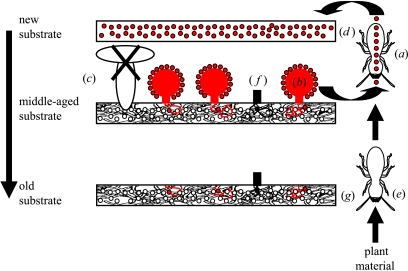Figure 1.
Schematic representation of the propagation of Termitomyces fungus within a Macrotermes termite colony based on Leuthold et al. (1989). Within a fungus garden young workers (a) consume nodules (b), which are modified unripe mushrooms, so that young termites suppress horizontal transmission (c). Nodules contain asexual, gut-resistant spores that are the inoculum for new substrate (d) constructed by young workers on top of the existing fungus garden from plant material collected by older workers (e). This propagation is associated with bottlenecks, since only a small fraction of the spores in one within-nest generation (shown in red) forms nodules, which produce all the inoculum for the next generation. Furthermore, there is selection for the production of nodules, as any non-nodule-producing mutant (shown in black) will be selected against (f). The lowest, oldest fragments (g) of fungus garden are consumed by older workers so that there is a continuous turn over of material from top to bottom within a fungus garden.

